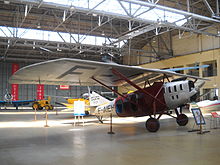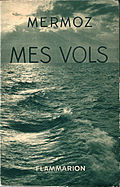Jean Mermoz
This article has multiple issues. Please help improve it or discuss these issues on the talk page. (Learn how and when to remove these messages)
|

Jean Mermoz (9 December 1901, Aubenton, Aisne – 7 December 1936) was a French aviator, viewed as a hero by many in both Argentina and his native France, where many schools bear his name. In Brazil, he also is recognized as a pioneer aviator.
Early years
Mermoz, infancy had been marked by World War I news. He became a lover of poetry, sculpture and other forms of art and literature. A shy and quiet adolescent, he graduated in 1919 determined that his career would be in aviation.
Career
In 1920 he met Max Delby, a teacher who helped him develop his career, and in April 1921 he flew as a pilot for the first time.
French Air Force
Mermoz joined the French Air Force in 1922, being assigned, as a pilot of the air force's 11th regiment, to duty in Syria. In 1924, he returned to France, having arguably been one of the most successful pilots in the Syrian operations. Mermoz relocated to Toulouse.
Latécoère

.

Later on, Mermoz went on to become an airmail pilot, with Latécoère's company, and almost failed his entry exam by performing dangerous stunts to impress the director. (The director, Didier Daurat had this famous quote: "We don't need acrobats here, we need bus drivers.") He then did a normal, flawless flight and was hired. It was there that Mermoz met Antoine de Saint-Exupéry. At the Compagnie Générale Aéropostale, Mermoz travelled to Morocco, Senegal and other African areas.
In 1926, one of Mermoz's flights ended with an accident, when his plane crashed in the Sahara. He was then taken hostage by a group of rebel Tuaregs, but was fortunately found later alive.
In 1927, Latécoère began building his own brand of planes to replace the aging World War I aircraft Breguet 14. The Latécoère 25, (or "Laté 25") and, later, the Latécoère 26 and Latécoère 28 proved to be efficient aircraft when flying from Morocco to Senegal, and Mermoz himself flew the types on those routes on multiple occasions.
But Africa was only the beginning. Latécoère's project was to create a direct airline between France and South America. By 1929, it had become evident that it would be economically viable for France to establish a commercial air route to South America, so Mermoz and others flew over the Andes. Despite Mermoz finding the flying conditions over the Andes to be tough, he became the project's main pilot, determined to reach the Pacific Ocean, and he was able, after multiple stops, to reach Santiago, Chile. During that time, to save time, he decided to fly during the night, using light beacons and flares as guides, and his fellow pilots, for once, were a bit reluctant to see him do it, because they knew it would be their turn next. For some time, as transatlantic flights were not yet possible, steamboats linked both halves of the "Line".
After flying from Saint-Louis, in Senegal, to Natal, Brazil, in 12–13 May 1930, the line was complete at last. Unfortunately, the modified Laté 28 "Comte-de-la-Vaulx" did not prove reliable enough, and had to ditch at sea during the return flight. Mermoz, his two companions and the mail were rescued, but the plane sank during the attempt to tow it.
Air France
In 1933, Mermoz was appointed general inspector by Air France. That same year, he arrived in Buenos Aires, Argentina, where he and Saint-Exupéry became important persons during the infancy of what would later become Aerolíneas Argentinas. Mermoz and Saint-Exupéry flew many dangerous flights for the then new air company. They became regarded as two of the most important men in the history of Argentine commercial aviation. From 1934 to 1936, Mermoz would fly private expeditions on Latécoère 300 airplanes. He flew 24 expeditions with that type. In 1935, he also flew de Havilland DH.88 "Comet" airplanes.
Disappearance at sea

On 7 December 1936 he turned back shortly after take-off to report a troublesome engine on his Latécoère 300 Croix-du-Sud ([Southern Cross] Error: {{Lang}}: text has italic markup (help)). After learning that he would have to wait for another one to be prepared, he took off again in the same plane after a quick repair, concerned that he would be late in delivering the mail. (His last words before boarding the plane were "Quick, let's not waste time anymore.")
Four hours later, the radio station received a short message, where Mermoz reported that he had to cut the power on the aft starboard engine. The message was interrupted abruptly. No further messages were received, and neither the Laté 300 nor the crew were ever recovered.
It is assumed that the engine they had tried to repair lost its propeller midflight, and being one of the aft engines, the loose propeller either badly damaged or cut the hull entirely, causing the plane to lose its tail and crash instantly. Henri Guillaumet, one of Mermoz's fellow pilots, had encountered the same problem a few months before, but as his own engine was on the forward side, airspeed had been sufficient to maintain the propeller in place until the landing.
The crew of Latécoère 300, "Croix-du-Sud", F-AKGF on 12/7/1936 were:
- Jean Mermoz, Pilot
- Alexandre Pichodou, Copilot
- Henri Ezan, Navigator
- Edgar Cruveilher, Radio Officer
- Jean Lavidalie, Mechanic
An unreliable plane
Mermoz had grown dissatisfied with the quality of the planes he and his companions had to pilot. In the months before his demise, he had been vocal about the aircraft's poor quality in both design and material, and was quoted saying "Ask me to pilot anything, even a wheelbarrow, but at one condition: make sure it is solid.". Another Laté 301, F-AOIK "Ville-de-Buenos-Aires", had disappeared eight months before his own, causing the death, among others, of his mechanic and friend Collenot. The complicated Hispano-Suiza 12Ner engines thought to be the cause of both crashes were later decommissioned and replaced with older, more reliable ones. His message had been heard too late.
Tributes
- France
- An avenue in Lyon (Avenue Jean Mermoz) as well as a metro station (Mermoz-Pinel) on Line D named in his honour.
- In 1937 Mermoz was honoured by a series of two French postage stamps bearing his image.
- A road in Paris (rue Jean Mermoz), between the Champs Elysées and rue Saint-Honoré has been named after him.
- The French city of Toulouse has a road (rue Jean Mermoz) and a subway station on Line A (Métro Mermoz) in his honour.
- The 1955 built French ocean liner Jean Mermoz was named after him.
- South America
- A French lycée in Buenos Aires, Argentina, is called after him. The Lycée Franco-Argentin Jean Mermoz, a bilingual school, is located in the intersection of Ramsay and Juramento streets in Belgrano neighbourhood.
- A monument to Jean Mermoz exists in the proximity to Jorge Newbery Airpark in Buenos Aires, Argentina.[1]
- One of the ATR-72 airliners (CX-JCL) in the fleet of BQB Líneas Aéreas is named after Jean Mermoz.[2]
- Lycée franco-chilien "Alliance Française" Jean-Mermoz
- Africa
- Other
- His epic flights over the Andes and across the Atlantic were commemorated in a film (Mermoz) for which Arthur Honegger wrote the music score. Two orchestral suites drawn from the score were recorded in the 1990s on CD and issued on the DG and Marco Polo labels.
Writings

- Mes vols (Flammarion, 1937) : an unfinished collection of memories (« My Flights ») published shortly after his death, along with short homages from his best-known friends and admirers.
- Défricheur du ciel (Bernard Marck (ed.), Archipel, 2006) : edition of Mermoz's correspondence from 1921 to his death in 1936.
References
Notes
- ^ "Ley CABA Nº: 3479/2010 - Mermoz Jean. Monumento. Avdas. Sarmiento y Costanera Rafael Obligado. Traslado". Ciudad y Derechos (in Spanish). 2010-08-17. Retrieved 2014-05-23.
- ^ "CX-JCL "Jean Mermoz" - ATR 72-212A Buquebus [BQB] Aeroparque (video)". DragTimes (in Spanish). 07-12-2013. Retrieved 2014-05-23.
{{cite web}}: Check date values in:|date=(help)
Bibliography
- Mermoz, Jean. Défricheur du ciel : correspondance, 1923-1936 assembled and presented by Bernard Marck. Paris: L'Archipel, 2001.
- Mermoz, Jean. Mes vols. preface by Gilbert Louis; notes by Bernard Marck. Paris: Flammarion, 2001.
- Heimermann, Benoît & Margot, Olivier. L'Aéropostale preface by Jean-Claude Killy. Paris: Arthaud, 1994.
External links
- Website of the Lycee Franco-Argentin Jean Mermoz in Buenos Aires, Argentina
- "Ley CABA Nº: 3479/2010 - Mermoz Jean. Monumento. Avdas. Sarmiento y Costanera Rafael Obligado. Traslado". Ciudad y Derechos (in Spanish). Ciudad Autónoma de Buenos Aires (CABA). 17-08-2010 (publication by CABA). Retrieved 2014-05-23.
{{cite web}}: Check date values in:|date=(help) - Official text of Ley CABA Nº: 3479/2010 - Jean Mermoz monument (in Spanish)
